A frosty start to winter
Wednesday, December 24, 2014
Just before this months news, there is an additional news
item I held over from October and November - the conclusion of the
celebrations for the life of Dylan Thomas on the the occasion of
the 100th Anniversary of his birth.
As his home town, Swansea pulled out all the stops with a wide
range of of events both in the city and Carmarthenshire , the
culmination of which, coincidiing with his birthdate on
the 27 October, was a 36 hour non- stop readiing of his works in 3
hour sessions., starting at 11.00 am on 26 October and ending at
11.00 pm on 27th, at The Grand Theatre in Swansea. Called The
Dylathon there were representatives from across a wide spectrum of
society in Wales and beyond. We attended the last session when all
the big guns came out - Sir Ian McKellen, Sian Philllips, The
President of the Irish Republic, The First Minster of The Welsh
Assembly, rugby stars, local actors and schoolchildren, and
memorably, a superb reading of ""Fern Hill", one of Dylan's
finest and best known poems. by The Prince of Wales.
To hear The Prince reading the poem go to
dylanthomas100.org/english/multimedia/prince-charles-reads-fern-hill/
If this link doesn't work for you, google " fern hill poem" and
scroll down to "Prince Charles reads Fern Hill". This should then
open in your browser
Just a few pics to give you a flavour of a never to be
forgotten event

Dylan keeps a close eye on Michael D. Higgins President
of the Irish Republic.
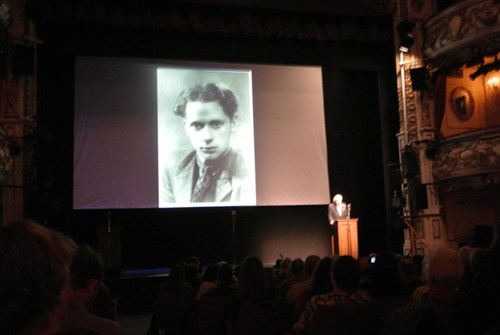
The backdrop of Llaregub (Laugharne) with Sir Ian
McKellan reading from a 1st edition of "Under Milk
Wood"

And what better way to end such a special occasion than
Morriston Male Voice Choir singing "Reverend, Eli Jenkins'
Prayer" from "Under Milk Wood"
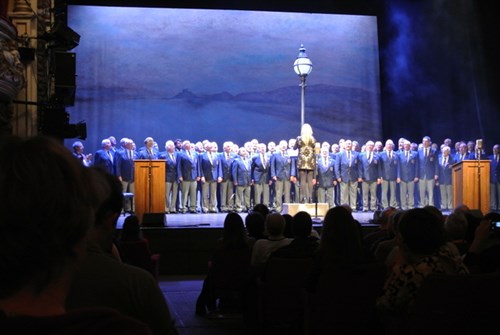
Starting to write this News Item well before the end of the
month, as I usually do with the Christmas edition, I am struggling
to find very much that is newsworthy., but by the time I complete
it I may be overtaken by events.!!This will be shorter than
December 2013 which was packed with news.
Weather
10 frosts in the first 14 days of the month (Min -6C on the 3rd)
suggested that it might be a cold December, but then the westerlies
returned with heavy rain and strong winds. Temperatures climbed
well above the monthly average. Max 12C, on the 18th.
Garden update
The combination of frosts and heavy rain abrubtly brought to an
end the late, great flower show that kept going until the end of
November. The only colour we now have is provided by early
flowering heathers, a few cyclamen coum, lonicera
pupusii Winter Beauty with its fragrant small white flowers, and a
couple of early hellebores
Cyclamen coum surrounded by beech mast
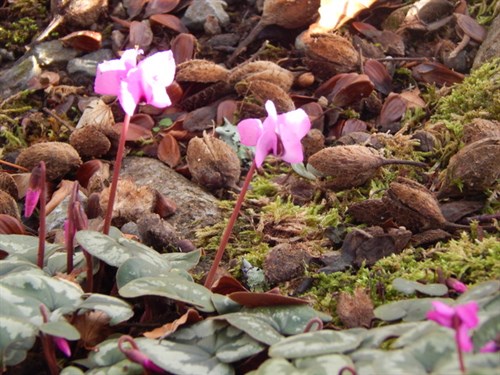
However there is the promise of the good things to come
with some advanced buds on many of the helleborus x hybridus,
emerging daffodils and the white tips of snowdrops beginning to
appear amongst the fallen leaves.
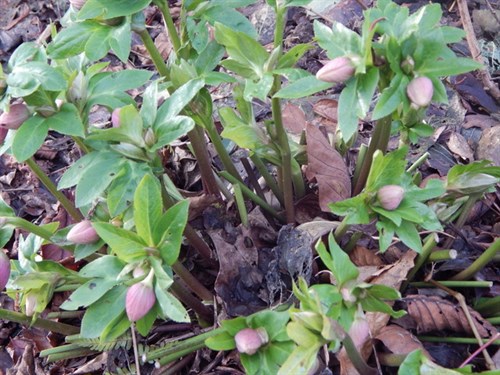
The Beech Hedge walk in the Paddock Garden, our main
early spring garden, looking rather bare but look out for how
this develops over the next few months
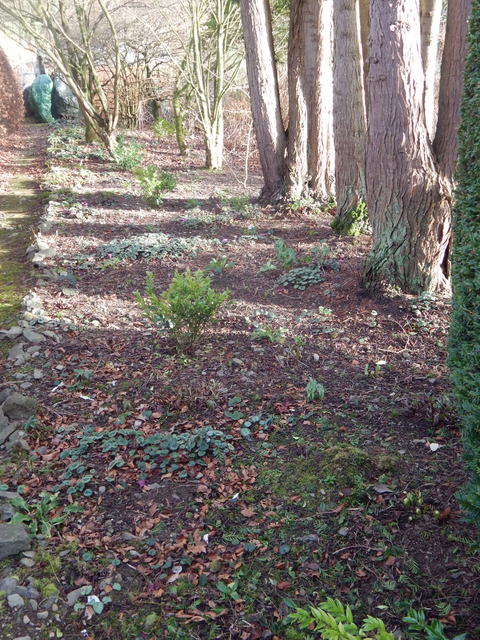
Grasses still contributing some structure to the Paddock
shade borders
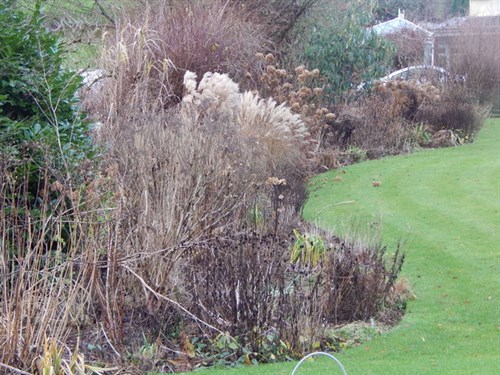
The only helleborus niger we have in bloom is in a pot in
the large tunnel; those in the garden ignore the fact that they are
supposed to be Christmas flowering and wait until the new
year.
Helleborus niger "Christmas Carol"
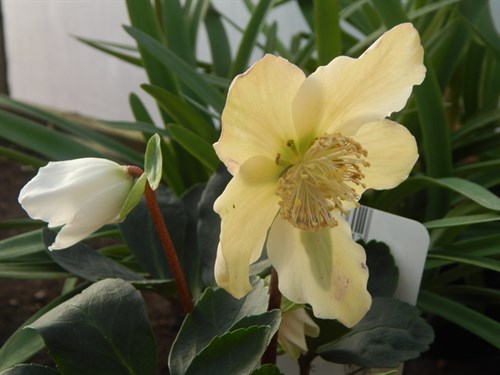
We do however have 2 species forms of hellebore in bloom,
h.odorus and h.liguricus, both with unremarkable but natural
looking flowers. They are however, unusually for a hellebore,
scented, with liguricus being the better of them with a strong,
quite sweet prefume. It could add another dimension to
hellebore breeding as most oif the crosses have great flowers but
no scent.
Helleborus odorus
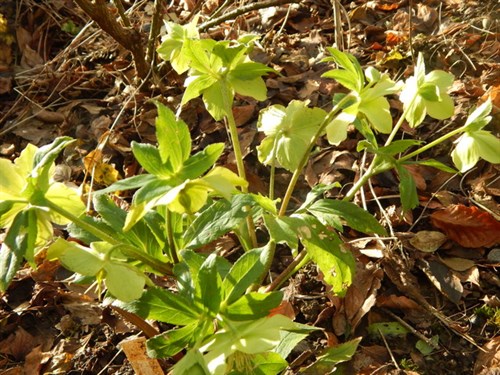
Helleborus liguricus
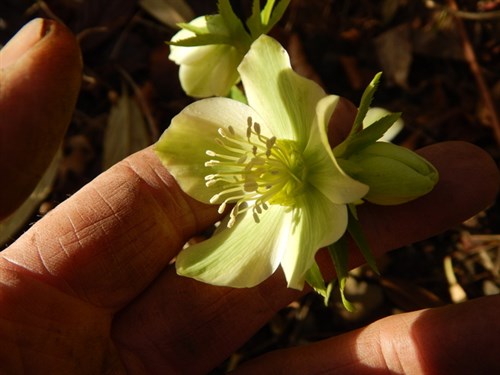
The fine weather early in the month was just what I needed to
get in the remaining firewood from the large oak woodland above
Trefynty. The verandah around the house is now stacked to the roof
and there is sawn wood under cover elsewhere. It is a real comfort
to have such fuel security and doubly so as it is all my own work.
It looks a lot of wood but with a wood burner in the lounge and a
cooker/boiler in the kitchen they gobble it up in colder spells (2
wheelbarrows a day at least). I reckon we burn between 25 -30 cu,
metres a year.
We had even more firewood once the tree surgeons had
been in to take down an alder growing at a precarious angle across
the Paddock Pond. Perhaps this would be a good way to work off the
excesses of Christmas if only I could overcome my fear of flying!
Suspended by a rope upside down left me in awe of 2 great guys who
did the work for us.
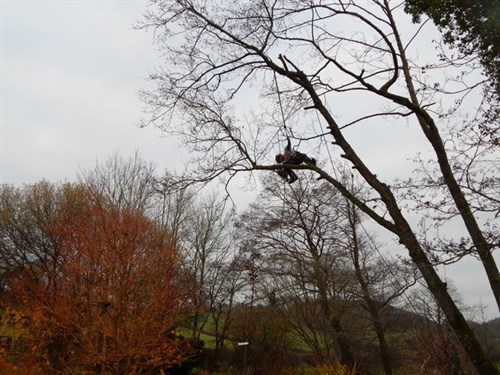
In the gardens I have started to remove the stakes from the
borders, tidy up and stregthen the border edgings and repair the
river bank at the bottom of tne Paddock Garden.
The retaining bank looks flimsy I admit but after my
remedial works hopefully the river will be prevented for a couple
of years from undercutting the bank and putting some special plants
at risk. The height from top to bottom is 7 feet and in a spate the
river comes almost up to the top but soon runs off
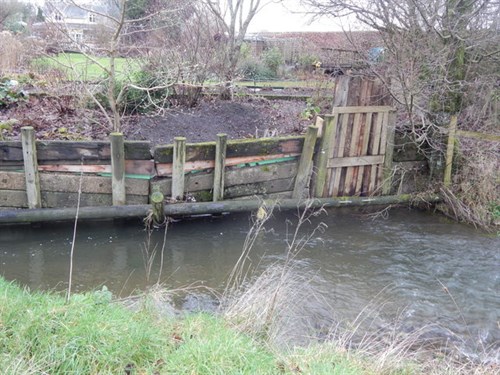
In the early evenings when it is too dark to work outside
but I still have energy to burn,there is always something to
do in the 2 tunnels and watering too with some plants still in
active growth.
I find this bench covered in some lovely
silver lichens most attractive - we are really struggling for
interest at this time of year!
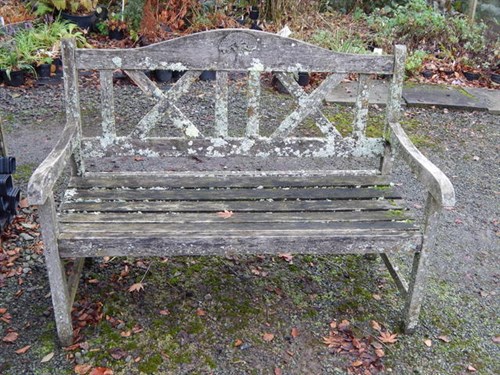
There are plenty of veggies for meals over the festive season
both in store and fresh from the garden. The sprouts are OK but not
the best I have grown. The taste has however noticeably improved
after the sharp frosts, being much sweeter and crisper. It's
surprising just how many people don't like the taste of sprouts but
there are so many new ways now to cook them and they are good for
us too. An often overlooked fact is that how any vegetables taste
depends on the variety, soil conditions, feeding, weather and most
importantly freshness which is why for me nothing tastes as good as
what you grow yourself. This is now being brought home
forcibly to me as we have started buying salad leaves again after
eating our own for 7 months. For a number of years I have grown
winter salad leaves in trays in the tunnels but most of them have a
death wish after a while and fall prey to botrytis or sometimes
aphids. If I had borders in the tunnels I am sure they would fare
much better.
What's looking good?
Not very much!!! I really am struggling so just a few pics will
say it all, Ancient Chines proverb - "One picture is worth a
thousand words" - I should remember that more often!
Christmas baubles in the large tunnel! The remaining
crop on the tomatoes, this year "Gourmet" (in the picture)
outlasted "Rosada"and are still quite edible especially when
cooked
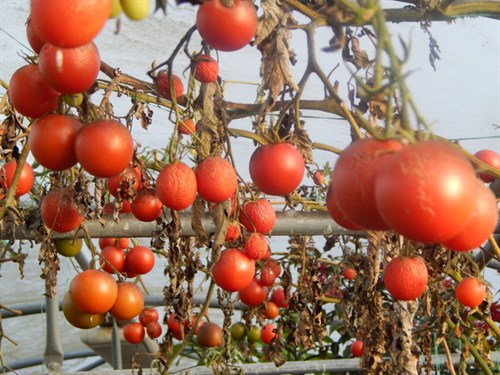
This picture was taken on 12 December shows my last
courgette from the garden (yes honestly). Picked on 23 November and
kept in the salad drawer of a fridge it was in good condition and
made a lovely simple dish with some of the tomatoes, our own yellow
peppers, garlic and onions sweated in olive oil with fresh herbs. A
taste of the Meditarranean in the winter in Waleas!
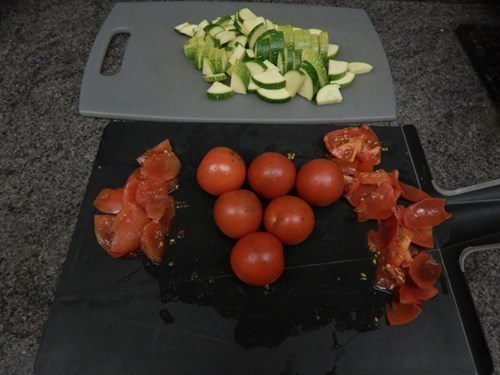
Asplenium scolopendrium "Cristata" a superb form and
amazingly a British native. Like polypodiums I wrote about in a
recent News Item, they can keep in good condition well into a mild
winter
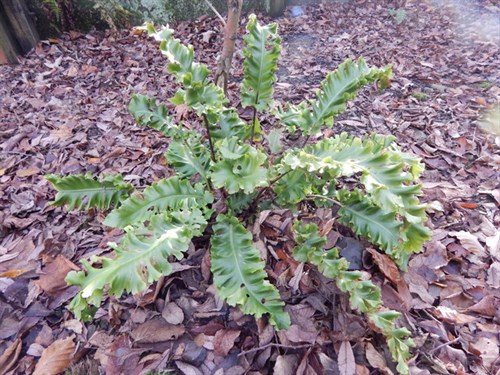
The polytunnels are a good source of uplifting colour
and this little beauty is a lone, late flower on hedychium
greenii.
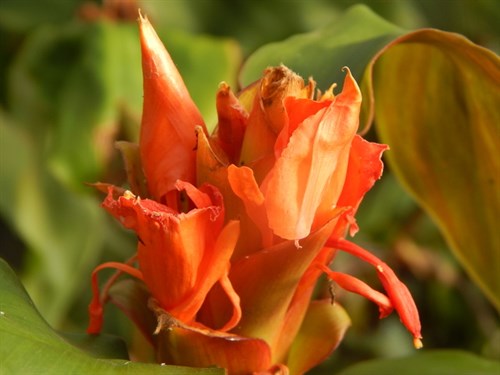
And this Kaffir Lily recently reclassified as
hesperantha, is an unknown form of a rather botanically confused
genus and hybrids. Don't the dark stamens set off the flowers
beautifully?
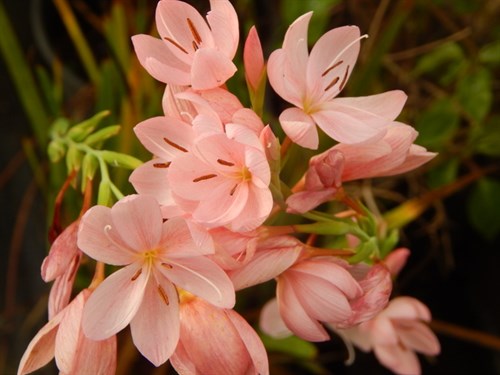
Wildlife and Countryside
At last we have had a few redwings around in the gardens and
adjoining fields but no fieldfare sightings. The moorhen
still makes occasional appearances on the Paddock Pond and there
are more herons around now than I have seen all year - but in
flight not in the pond thank goodness. Starlings in small numbers
put on show most days but so far not in big numbers.
On milder nights, in the light of a strong torch, there are many
young rudd on the move in the Paddock Pond, I will soon need to put
up the electric fence around it just to keep the otters at bay, as
they become more of a nuisance at this time of year.
No lambs as yet as my neighbours with the Dorset sheep are now
tending to go for later lambing. It has almost become a feature of
Christmas (quite fitting in a religous sense) to have at least a
few lambs in the neighbouring fields.
The next day after writing this, in the morning on a tour of the
gardens, I noticed around the Paddock Pond traces of fish scales on
the bank. Sure evidence of a night time visit by an otter. It
is quite a regular occurence at this time of year as young otters
move upstream to find territories of their own. The Paddock Pond is
conveniently situated above the River Ydw which forms a boundary
with the gardens.
Fish scales in the grass and an unmistakable otter
spraint, the black deposit at the bottom of the
picture
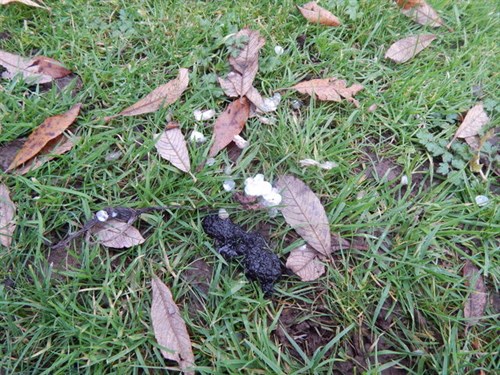
Visits
With no viisits of our own to report I was glad to have the
opportunity recently of experiencing second hand a trip to the
eastern Himalayas. A few months ago, as a regular customer of
Plantworld Seeds, I was invited to sponsor a plant hunting trip to
Nepal by Ray Brown the owner, David Howard, former Head Gardener to
The Prince of Wales at Highgrove and Nigel Veitch. The deal was
that in return for a speciified donation I would be sent seeds
collected on the trip. I opted not surprisingly for a selection of
annuals and perennials. When they arrived earlier this month they
were accompanied by a fascinating account of the trip which shows
the lengths that plant hunters go to and the hardships they endure
in their search for undiscovered treasures. I would like to share
with you a brief summary of it.
The indominatable trio having a refreshment break in the
mountains - looks like taking tea in a British Garden. It makes you
fell proud in its eccentricity - even a table cloth!
Superb.
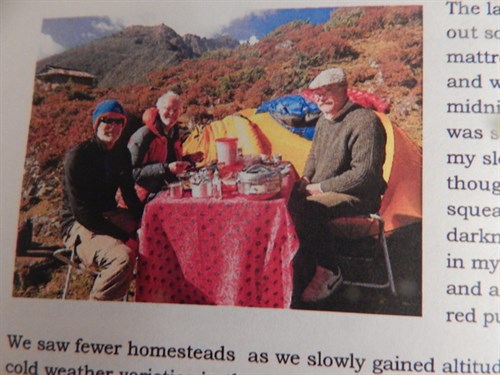
Setting out from Katmandu with 9 Sherpas they trekked for 4
weeks climbing to over 4,000 metres. On the way up they encountered
many hazards including poisonous snakes, leeches, monsoon rain and
thunder, rope bridges and some discomfort from the altitude. They
camped and occasionally stayed in buildings on local farms. It was
at one of them that Ray had the chilling experience of waking up in
the middle of the night when he felt what he thought was someone
stroking his hand only to find that he had in his sleeping bag a
rat which squealed when he grabbed it and raced off onto the
darkness! (the rat - not Ray!!) The determination to find plants
drove on our intrepid group but at lower levels there was a
lack of collectable material because of the intense grazing by
yaks. What material they did find was in awkward places that the
yaks could not reach. Many of their best finds however were at over
3000 metres in boulder strewn screes.
Although late in the season which made identification difficult,
seed from 79 different plants was collected. Genus represented
included aconitum, ariasaema and other unidentified arums,
cotoneaster, gaulteria, a suprising range of gentians and
associated relatives, and impatiens. Trees and shrubs
included roses, rubus, oak, rhododendron, sambucus and berberis.
Ray was delighted to find the rare and incredible megacodon
stylophorus, the so called Dinosaur or Giant gentian, and the
amazing rheum nobile (google it for pics and it will be on
your late Christmas list!) with huge paper like spathes growing
amongst the deep scree. Knowing the preferred conditions of plants
growing in the wild is a sure way of placing them successfully in
the garden.
In Ray's account of the trip there were also some touching human
interest accounts , none more so than that of the main sherpa
leader Lhakpa, who received a message via the group's satellite
phone that his elderly mother had been taken to hospital seriously
ill. Lhakpa set off immediately with 2 porters. In the space of
just 14 hours running and jumping over 35 miles of rocky terrain he
reached a rough road, arriving at the hospital in Katmandu next day
- but he was just too late as his mother had died earlier that
morning.
I am sorry that space prevents me for sharing more of this
amazing trip wiith you and there is nothing on Ray's website about
it, but nevertheless the website is worth a visit and I can
wholeheartedly recommend it to you.
After I had received my seed allocation I contacted Ray to
congratulate him on his achievement and to enquire if any seed of
impatiens was still available, Expressing my interest in the genus,
Ray very kindly shared with me seed of all those he collected which
is very much in character for a man I have long admired and I hope
I will be able to germinate notoriously difficult seed. It is so
exciting because some may be totally new to cultivation.
Go to www.plant-world-seeds.com
for details of the range of seeds generally available and a free
catalogue
From foreign parts back to the here and now and with Christmas
just a few days away may I wish you all the Seasons Greetings and a
most successful and healthy 2015. Do keep visiting our website and
if you can, please come and see the gardens some time between 1
June and 31 August.
Keith and Moira